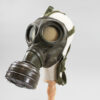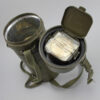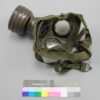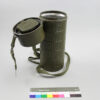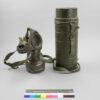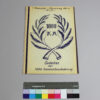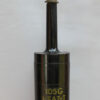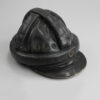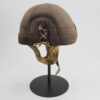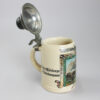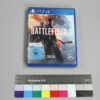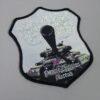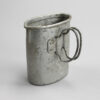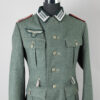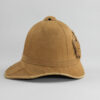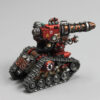NBC protective mask of the German Armed Forces
Inventory number: Ü 444
The Bundeswehr was established in 1955 at a time when there was an imminent threat of nuclear war. Divided Germany formed the front line in the confrontation between the Western powers of NATO and the Warsaw Treaty states in the East. The atomic bombs dropped by the USA on the Japanese cities of Hiroshima and Nagasaki were less than 10 years old. In the early 1950s, nuclear warheads could already be built so small that they could be used on short-range missiles and as artillery ammunition. The Soviet Union already had systems mounted on an IS-3 chassis in the mid-1950s, and later US systems even included short-range projectiles that could be fired from a jeep. This was accompanied by a change in operational doctrine: nuclear weapons were no longer just weapons that could blow up entire cities, but were to be used tactically on the battlefield and become part of conventional warfare.
For the soldiers, this meant closer contact with these weapons and their consequences on the battlefield. Not only were the artillery soldiers firing the warheads ever closer to their contaminated target. In Warsaw Pact maneuvers, tactical nuclear weapons were used to support their own attack. After two waves of nuclear strikes on the North German Plain, its own armored and motorized rifle units were to advance into the contaminated area. NATO also planned a two-phase war on German territory, in which the European armed forces were to hold off the enemy until US nuclear weapons were ready and then advance again with army units after their use.
In addition to this nuclear threat, biological and chemical weapons had already been in use for some time; soldiers were given protective masks against gas warfare agents as early as the First World War. The Bundeswehr’s initial equipment thus included personal A(tomar)B(iological)C(hemical) protective equipment, which also included a mask. This was no longer called a gas mask, but an NBC protective mask, as it was intended to protect not only against C-substances such as gas, but also against airborne particles from categories A and B. The NBC protective mask 54A was based on the Wehrmacht’s gas mask 38; the second model 54B with a separate exhalation valve was only rarely issued.
The mask is made of rubberized fabric. To ensure a tight fit, the edge is covered with suede and the head straps are adjustable. A metal box was used for storage, in which replacement filters and replacement lenses for the eye shields could also be kept. These lenses were specially coated to prevent fogging and were made of gelatine-coated celluloid in this early model. Various filters could be screwed into the mask. The standard FR 55 filter consists of a fiber that filters contaminated airborne particles and activated carbon that binds gases and vapors. For service in tanks and other enclosed spaces such as ships, the FE 55 filter was used, which can also bind carbon monoxide.
In the event of an NBC attack, the soldiers were to put on their masks and other protective equipment within 30 seconds, with as little contact as possible with the possibly already contaminated ground. At that time, the tanks used by the Bundeswehr had no or only rudimentary NBC protection. In the event of a nuclear attack, the soldiers would have had to march through contaminated areas and wiped-out cities, over destroyed roads and bridges, through burning forests and an enormous number of civilian casualties. Whether the soldiers could have survived such an apocalyptic environment with this protective equipment was fortunately never proven in practice.
Object of the month
(short) stories from the depot
Unfortunately, many objects cannot currently be shown in the exhibition for conservation reasons. Here you will find unusual objects and exciting stories of special pieces from the depot


